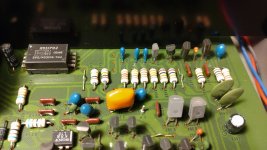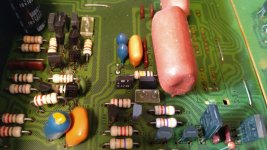What would you do - based on your experience - with these blue drops - leave them, replace them? Device is "open" anyway and replacement lytics would not cost much.Only good experiences with modern SMD versions, the drop type through hole types were a disaster.
Attachments
Mmm, I would definitely replace the ones directly connected to rails as these have the highest risk for spontaneous failure. Well since I have modern TH tantalums in stock I would replace them all for recent tantalum caps. Or….solid aluminium caps. Anything with dry electrolyte or!?!?
Except when they’re used as coupling caps. For values under 10 uF you better use film caps 5 mm.
As you could read the conscience has influence. Modern tantalum caps are really good but what when the coltan has been bought with weapons!? Tainted reputations hardly get a second chance, I know. Strange that it does not work like that with gold isn’t it!?
Except when they’re used as coupling caps. For values under 10 uF you better use film caps 5 mm.
As you could read the conscience has influence. Modern tantalum caps are really good but what when the coltan has been bought with weapons!? Tainted reputations hardly get a second chance, I know. Strange that it does not work like that with gold isn’t it!?
Last edited:
Read this very quickly, as the moderators might remove it: because of American legislation (Dodd-Frank act), many parts manufacturers and solder manufacturers nowadays have a statement about conflict minerals, usually stating that they have done their best to avoid conflict tantalum, tin, tungsten and gold.
You wrote about "modern" capacitors. Aren't those by definition capacitors manufactured nowadays?
Ha! You got me! Or not?!
Modern in the sense that they are way less old than the drop type but not exactly produced from 2022 mined coltan. Anyway not much of interest to the OP. Secondly are "modern" and "nowadays" not synonyms. "Modern" in the sense of "not ancient".
https://wikidiff.com/modern/nowadays
Modern in the sense that they are way less old than the drop type but not exactly produced from 2022 mined coltan. Anyway not much of interest to the OP. Secondly are "modern" and "nowadays" not synonyms. "Modern" in the sense of "not ancient".
https://wikidiff.com/modern/nowadays
Well, most of them are directly on power rails - in a "quite standard" (by nature) preamplifier from end of 70-ies.Mmm, I would definitely replace the ones directly connected to rails as these have the highest risk for spontaneous failure. Well since I have modern TH tantalums in stock I would replace them all for recent tantalum caps. Or….solid aluminium caps. Anything with dry electrolyte or!?!?
And one of these has already been replaced earlier (with a standard lytics) together with the power regulator transistor that it probably took out.
Also - no substantial voltage derating applied - 35V caps are in 30V rails.
Why strive for solid capacitors - their application is quite standard and "everybody" is using regular lytics in these places...
What is peculiar that also signal path capacitors are mostly tantalum - I do not seem to recollect such an obsession with tantalums from other amplifiers of that era...
These brick types any different from drops?
Attachments
What "everybody" and gurus use and should be done according those is not my culture, sorry. Bad experiences following herds and leaders.
With tantalum caps it has always been wise (and it is still wise) to use 2x higher voltage ratings than the maximum DC voltage of the device. Directly used on power rails the drop type are incidents waiting to happen. So I would use new ones that are reliable. That everybody uses electrolytic caps is an economic choice as tantalum caps are better. Check the prices and specifications. In some cultures cheap is the keyword and cheaper is even better. So choices are solely made based on costs, not on quality. Check some threads here and discover that many have it in their system to do stuff as cheap as possible. That apparently is "good".
Wet type electrolytic cap dry out so if you have the choice like I have then solid aluminum caps and film caps are preferred whatever "everybody" likes to think about that when they're busy calculating lowest costs.
Some British cottage industry brands used tantalum caps everywhere but unfortunately the tantalum caps of that time were not reliable and caused the bad reputation of tantalums reliability. My assumption is that they used certain parts as a kind of trademark, to make them different from the rest.
With tantalum caps it has always been wise (and it is still wise) to use 2x higher voltage ratings than the maximum DC voltage of the device. Directly used on power rails the drop type are incidents waiting to happen. So I would use new ones that are reliable. That everybody uses electrolytic caps is an economic choice as tantalum caps are better. Check the prices and specifications. In some cultures cheap is the keyword and cheaper is even better. So choices are solely made based on costs, not on quality. Check some threads here and discover that many have it in their system to do stuff as cheap as possible. That apparently is "good".
Wet type electrolytic cap dry out so if you have the choice like I have then solid aluminum caps and film caps are preferred whatever "everybody" likes to think about that when they're busy calculating lowest costs.
Some British cottage industry brands used tantalum caps everywhere but unfortunately the tantalum caps of that time were not reliable and caused the bad reputation of tantalums reliability. My assumption is that they used certain parts as a kind of trademark, to make them different from the rest.
Last edited:
I was referring to other known audio equipment manufacturers of that era, not the DIY people as "mainstream" 😉What "everybody" and gurus use and should be done according those is not my culture, sorry.
...
So choices are solely made based on costs, not on quality.
Fair enough; the New Church in my hometown was built in 1648.Modern in the sense that they are way less old than the drop type but not exactly produced from 2022 mined coltan.
Colleagues used the words "old" and "new" on labels for cables, devices and such. 5 years later no one knew anymore what was old and new or better said "old" and "older". My (cough) bright idea was to just use the year of installation in the name label 🙂
Last edited:
- Home
- Design & Build
- Parts
- A small sample of historic capacitors tested and compared

